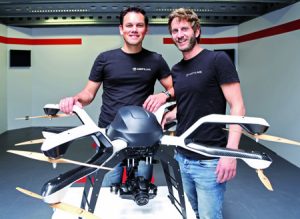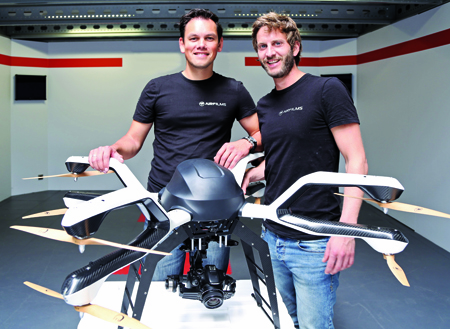Dutch production house Airfilms has a growing repertoire of aerial cinematography projects in the region. In an exclusive chat with Vibhuti Arora, Airfilms talks about its expertise and what it takes to fly drones The idea of replacing expensive helicopters with cost-effective unmanned aerial vehicles (UAV) or drones is catching up with producers, […]
 Dutch production house Airfilms has a growing repertoire of aerial cinematography projects in the region. In an exclusive chat with Vibhuti Arora, Airfilms talks about its expertise and what it takes to fly drones
Dutch production house Airfilms has a growing repertoire of aerial cinematography projects in the region. In an exclusive chat with Vibhuti Arora, Airfilms talks about its expertise and what it takes to fly drones
The idea of replacing expensive helicopters with cost-effective unmanned aerial vehicles (UAV) or drones is catching up with producers, but it is yet to achieve the quality and finesse required in more sophisticated shoots. Experts believe that aerial cinematography using unmanned aerial vehicles is a work in progress and that the production quality is getting better by the day. They also agree that drones hold great promise when it comes to broadcasting live events, making a lot of shooting angles possible that were previously deemed difficult or even impossible to achieve.
UAV production shot to fame in the region with the December 2012 live broadcast of the camel races in Qatar. Airfilms, a Dutch production house, undertook the aerial part of the broadcast for this project. Airfilms had an exclusive contract with Al Rayyan TV to produce aerial footage for the races and the production house has since been producing the event for live television broadcast, every year.
“We have covered several live broadcast events all over the world in different conditions. Be it camel racing at very high temperatures or football matches in the rain, or offshore sailing and triathlons, we have experience in the harshest conditions. Our drones have filmed even with wind speed of up to 70 km/h,” says Bart Hartge, Managing Director, Airfilms Production BV.
Hartge and Marvin Dechene, Team Leader Operations, Airfilms, were in the UAE recently to film the soccer matches between Manchester City and Al Ain. Although very different to the camel races, filming soccer from the air was as exciting and challenging for the producers.
The camel races
The production house did not have a handbook to cover the camel races; their method was devised through trial and error before mastering the technique. When they started out, live feeds used to be shaky and the footage was not crisp, but the technology has steadily evolved over the years.
“There was a time when video drones were a nightmare in terms of image stability, safety and performance. In the last three years we have improved tremendously where stability of images is concerned. Even in windy conditions, light live broadcast setups work quite well,” says Hartge.
Filming using drones involves two-man operations a pilot and a cameraman.
“They need to understand the programme and the needs of the director,” comments Dechene. The drone works on batteries and is controlled remotely from the pick-up truck that follows the camels. It takes off before the race starts. This being a very energy intensive shoot, the batteries need to be replaced every 15 minutes during the shoot.
The camera on the drone gives a birds eye view and wide angle view of the distance between the camels.
“We have to maintain a distance to have a birds eye view of the subjects. We offer a supplementary camera as most of our shoots involve multiple cameras on the field. Technically we can go up to 15km in one stretch; we always keep the line of sight with the drone not further than 1km, but most of the filming is done within a range of 300m,” says Dechene.
The footage is then streamed to the OB van using the Cobham transmitter on the drone and the receiver on the OB van. It is then mixed with the footage received from the main cameras placed on different positions on the tracks.
“We offer a plug and play solution that delivers full HD H264 video signal seamlessly into any broadcast environment with very low latency. The system is easy to integrate and can serve as a single camera standalone system or can be integrated into any existing environment.”
The drones return to their GPS home position if signal interference occurs. The camel races broadcast have had about 30% aerial footage, while the soccer matches have had approximately 8%.
High temperatures, dusty conditions and high wind speeds pose a major challenge to operating UAVs in the region.
“From our past experience of operating in the region we have worked out ways to ensure that our aerial devices deliver optimum quality. High temperatures, along with high humidity and dusty conditions, are potentially damaging to all kinds of electronics, especially if the equipment is used outdoors. The equipment that we use in the Gulf region has to be serviced more often than the kit we deploy in, say, Europe,” explains Dechene.
Adhering to European laws, in terms of organisation, Airfilms Productions is obliged to follow the operation manual approved by EURO USC. The operator(s) need to be certified by EURO USC.
Unlike the camel races, where drones are active at the time of the actual races, in a soccer match the main role of the drone is only before the match, when the players start arriving in the stadium, during rest and for post-match ceremonies. During the match the director can cut to aerials if time permits, but it’s mainly the ground footage thats used.
What makes a drone
Hartge points out that all the components in a drone are based on market requirements, as each drone is custom designed according to the job it is meant to do.
“It is a combination of a perfectly functioning platform in all weather conditions (wind, heat, sand) and very skilled operators. Every second of your shot footage need to be stable and usable. The challenges are mostly the weather: salty wind, sand and heat are terrible for the electronic components. You need to evaluate your hardware all the time and a very strict maintenance plan is mandatory.”
The key components of a drone are the flight controller (auto pilot), motor management, motors and three-axis direct drive gimbal. The cameras presently in use include the Panasonic GH4/M Zuiko, remote IRIS, Cobham Solo7 HD Nano Transmitter and the Cobham ProRX receiver decoder, with 8-way diversity.
“We worked and tested with several electronics suppliers to achieve a redundant and safe setup. We started using Cobham components in August 2013,” says Hartge.
Airfilms has now used Cobham Broadcasts Nano HD transmitter with drones for a range of high-profile events in the Middle East. The ultra-miniature Nano HD is an HD digital video transmitter designed specifically for point-of-view (POV), body-worn and aerial applications.
Airfilms Production provides the send and receive sites, which are installed and connected to the OB van. The drone’s transmitter sends the data directly to the OB van, where they mix and record the images.
According to Dechene, weight is an important factor in how long a remotely controlled airborne vehicle can stay aloft.
“Cobhams Nano HD is so light yet powerful and reliable that it has greatly extended our ability to capture aerial footage,” he explains.
Airfilms has used the Nano HDTX transmitter on everything from camel racing to motor and horse racing to provide a comprehensive view of the overall action. With Cobham COFDM and H.264 encoding technology at its core, the transmitter provides video images over the wireless link and supports composite, SDI, HD-SDI and HDMI video input formats.
“We are focusing on worldwide live events because thats one area where aerial photography can provide very valuable footage. Our objective is to increase the flight time with the camera control unit from the OB van. We are well aware that we need to constantly update and improve our offerings to provide better solutions. Tailor-made solutions for the film and ad industry are also on the cards,” comments Hartge.










































































